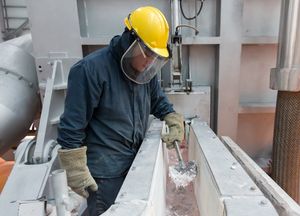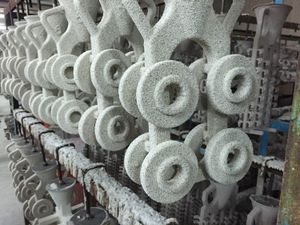What does that mean?
Something about Apple's MacBook Air announcements last week struck me: The claim about its enclosure being made from “100% recycled aluminum.” On stage at the event, Vice President of Hardware Engineering Laura Legros said: “We use aluminum because it has incredible strength, durability, and sheer beauty. To achieve that we've had to rely on mining high purity ore. That is, until today.”
To give a little more context I reached out to Adam Minter, who covers the global recycling industry and grew up on a scrap yard himself. Adam’s book, Junkyard Planet, was one of my favorite books this year, and his column for Bloomberg (and the archives of his dormant blog, Shanghai Scrap) forces you to rethink the way you think about how humans produce, use, and discard goods. Our email conversation is below.
Spencer Wright: My first question is: Does Apple's claim even make sense? What did their aluminum supply chain look like before this announcement, and how much of a shift does this announcement signify?
Adam Minter: Apple's marketing department has a history of taking the most prosaic of technologies and spinning them as revolutionary. That may be great salesmanship. But for anyone trying to understand what the heck they're actually doing, it can be frustration-inducing. And this appears to be one of those cases.
First, it's not at all surprising that Apple has had rely on "pure ore" to meet the spec for its aluminum MacBook enclosures. The problem is that recycled aluminum, for all of its advantages, often isn't "pure" at all. Processors and smelters do their best to segregate different metals and alloys, and sort out impurities (ranging from paints to... different metals). But it's an expensive process that requires often proprietary technology. As a result, there's lots of aluminum out there that collects impurities over time, becoming less and less useful. That's particularly the case in developing regions, where technology - and incentives - to purify the metal are lower.
When I started reporting on Chinese recycling in the early 2000s, the problem was widely acknowledged to be undermining the reputation and competitiveness of China's manufacturers. The problem wasn't just aluminum, either. In 2007, the government-supported Shanghai Electric Cable Research Institute reported that nearly 80% of the wire/cable products produced in Guangdong Province were unqualified, with 49.6% not meeting the standard electrical resistance index (sorry, I don’t have the link --- but I was present at the conference). The vast majority of those "products" were made from imported recycled metal. Not more than six months after the report was issued I smelled smoke in my Shanghai apartment. The source, it turned out, was the power cord to a new space heater. It was overheating and melting the insulation.
Anyway, the Chinese aluminum recycling industry has long faced similar problems, and I suspect that's what kept Apple from relying upon it for cases. Whatever alloy they use for the MacBook, it couldn't be met. But slowly, those quality problems have been solved. Chinese smelters are investing in better and better technology (in many cases, better than what's found in many developed countries). And I suspect that Apple has found one that can meet its spec using recycled material, and do it at a large scale.
Apple's claim that it has found a technique that uses excess aluminum from its production process to create a greener MacBook is, well, a little strange. For as long as there has been metal recycling, manufacturers have recovered metal wastage from the process and injected it back into the process (full disclosure: I grew up in a junkyard family that collected cuttings from small factories and sold them to smelters, among other customers). Perhaps there's something more to it, but my guess is that Apple is sending its cuttings back to the smelter producing the alloy for its cases. That's a great way to ensure it maintains the spec.
SW: In other words Apple has always been recycling their cuttings, right? And what’s new in this announcement is that a few of their products will be made from a 100% pre-consumer recycled aluminum rather than a mix of virgin and recycled material?
AM: I haven’t seen or been briefed on Apple’s manufacturing or recycling processes (I’ve tried, believe me), so please take my answers as well-informed speculation. But yes, Apple has always recycled their cuttings. That’s a standard industry practice in every manufacturing environment that’s ever existed. And yes, based upon the very vague announcement, they’re using pre-consumer cuttings and mixing them with some mix of recycled aluminum.
SW: What's the volume at which Apple (or any company) could cost effectively set up a dedicated recycling line, which processes only Apple-created pre-consumer waste and converts it into feedstock that only Apple will use? Apple makes roughly 20 million Macs per year, and a big portion of their product lineup is housed in machined aluminum enclosures. No matter how much they optimize their feedstock and toolpaths, the slots, pockets, and holes in their Mac line - not to mention iPhone 7, 8, and Xr - all add up to a *lot* of pre-consumer aluminum waste. What’s the difference between recycling that waste on a dedicated line vs. selling it on the open market?
AM: There’s a wide range of ways that companies manage their recyclable manufacturing waste. For example, secondary steel mills generally manage it themselves and inject it back into their heats. But consumer product manufacturers generally take one of two approaches. Either they collect and sell it to a scrap company that then sells it into the open market. Or they set up a tolling arrangement whereby a processor collects and reprocesses the scrap into a reusable raw material, all the while the original owner - in this case, Apple - maintains ownership of it. Apple is probably doing the latter. From a purely financial perspective, it’s not going to be as profitable as selling those nice aluminum shavings into the open market. But Apple has obviously decided that the cost of bringing it back into its factories is worth it, both for environmental and PR reasons.
SW: Where does this, and Apple solar power initiatives, etc, fit into their overall environmental impact? I'm thinking in particular of how using pre-consumer recycled aluminum compares to their efforts to prevent their own products from being repaired, but there may be other angles.
AM: Convoluted marketing language aside, this is all really good news if you care about Apple's environmental footprint. Aluminum smelting is one of the most energy-intensive manufacturing processes in existence. For standard aluminum cans, for example, the potential energy savings that a manufacturer achieves by using recycling versus primary aluminum can range as high as 90 percent. I'm in no position to calculate how much that reduces Apple's carbon footprint compared to its solar power initiatives. But it will be significant.
Thanks to Adam Minter for his help with this piece. For more coverage on the manufacturing operations of companies like Apple, subscribe to Scope of Work’s excellent weekly newsletter.



